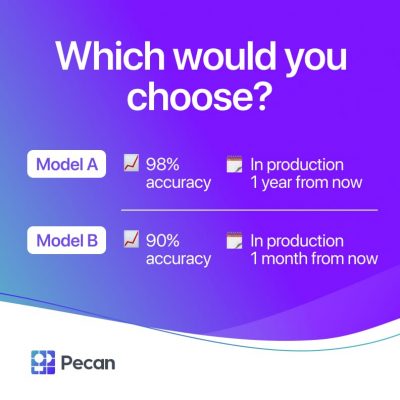Welcome to the sixth article in our 3-Minute Nutshell series. We answer FAQs about predictive analytics in just a few minutes of your time! Get up to speed on the key things you need to know to start your business’s journey toward AI success. Catch up with the series now:
- What is predictive analytics?
- Is predictive analytics the same as data science, machine learning, and AI?
- What skills do you need to do predictive analytics?
- Can predictive analytics be automated?
- What are the best uses for predictive analytics in business?
… and now: How accurate are predictions from predictive analytics?
Psychics, tarot cards, and the Magic 8 Ball: All of these claim to be able to predict the future. But we wouldn’t recommend you use them for your business. Predictive analytics provides far more accurate predictions.
But how do we know that predictive analytics is accurate?
We can understand why people might wonder. While businesses possess vast amounts of data today, using that data for predictive modeling is still mysterious to many. And without a deep understanding of how the process works, it’s entirely reasonable to question the accuracy of predictive analytics and feel hesitant.
In addition, marketing decision-makers are struggling to feel good about their data collection and analytics. Only 28% feel “very confident” in how their data analytics supports them in winning and retaining customers. Our recent State of Predictive Analytics in Marketing 2022 research found similar issues. Among the marketing leaders we surveyed, 84% agreed it was difficult to make day-to-day data-driven decisions and take action.
Fortunately, you can trust predictive analytics to accurately guide confident decisions. Let’s see why.
Defining Accuracy
Accuracy has a specific definition in evaluating predictive analytics models. It’s one way to check how well a model uses historical data to generate predictions that match reality. First, training and test data are used to check the model’s accuracy as it’s developed. Then, data professionals monitor accuracy on an ongoing basis once a model is in production.
Calculating accuracy is a lot like grading a test in school. For example, if a test had 100 yes/no questions and you got 95 right, you’d get a grade of 95%. Accuracy is calculated the same way. It’s the number of correct predictions divided by the total number of predictions.
Because accuracy is intuitive and easy to calculate, it’s a standard metric to assess predictive models. It’s only one metric, though. Others, such as precision and recall, are better suited for specific business applications of predictive analytics.
When Accuracy Matters
If you got a grade of 98% on a test and your friend earned 95%, it’s obvious which grade is “better.” But the better option may not always be so apparent if you’re choosing between predictive models. Consider these two options:
Which would you choose?
Consider the opportunity cost of waiting for Model A. Business leaders who are evaluating different strategies for implementing predictive analytics often face this dilemma.
If you’re developing a model that predicts high-stakes medical diagnoses, it may be worth the time and effort to achieve exceptional model performance.
But instead, maybe you want to anticipate customer churn. Right now, you might feel like your identification of customers likely to churn is no more accurate than flipping a coin. In that case, a rapidly built model with 90% or even 80% accuracy could help you start retaining many more customers in the short term. Further iterations could offer even stronger model performance and ROI in the long term.
So while accuracy is often a valuable measure of predictive models’ performance, it’s not the only measure — and slight differences may not be worth pursuing in the short term. And, of course, a long delay may mean that behavior changes make models obsolete before they’re deployed.
Nevertheless, data scientists often feel compelled to achieve the greatest possible model performance, despite the greater expense, time, and opportunity cost entailed. They tend to be more focused on statistical measures of models’ success instead of meaningful business measures. That’s why we recommend an efficient approach to predictive analytics that accelerates business impact, balancing accuracy with time-to- and time-in-market.
Building Trust in Accurate Predictions
Even if a data professional says a predictive model offers accurate predictions, it still may be hard to trust the model enough to use it to allocate your precious marketing resources. The AI trust gap is real.
A predictive modeling approach that provides explainable predictions can be a significant source of reassurance. Explainability in this context means you can see which factors most influenced each prediction in your model’s output.
These explanations are helpful for various purposes, such as creating better customer segments or developing high-level strategies to improve the customer experience. They also help dispel doubts about how predictions are generated. As a result, explainable predictions deepen trust in AI models and increase your confidence in making decisions based on those predictions.
Doubts and concerns are natural parts of any new adventure. But predictive analytics has proven time and again to be a reliable guide for data-driven decision-making and strategy. Testing out a single impactful use case could be a perfect first step toward a fully fledged predictive analytics program — and toward building trust and confidence in the accuracy and utility of prediction.
Ready to explore how accurate, reliable predictive analytics can support your business’s goals and growth? Get in touch — we’d love to help you choose the right first steps.






